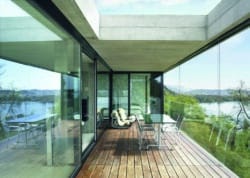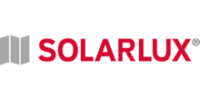The general perception of aluminium doors and windows has vastly improved over the last few years. Some of the typical misconceptions about aluminium windows and doors have been successfully put to bed. It is no longer true that:
- Aluminium is not thermally efficient, is cold and condensates.
- Aluminium windows and doors are ‘commercial’ windows.
- Aluminium windows and doors are high maintenance.
Aluminium doors are now better than ever.

The reality is that the awareness of aluminium in the eyes of the end-user customer is now better than ever before. Much of this is to do with recent innovations in aluminium design, extrusions and performance.
The development of the polyamide thermal break is one great feature found in aluminium doors and windows. The thermal break is responsible for giving aluminium frames their thermal properties and great U Values when used with various glass combinations. The thermal break has also enabled customers to have an excellent colour choice. Different colours inside and out are now possible thanks to the polyamide thermal break.
The other great feature of aluminium doors especially is how large they can be made from the slimmest sections. Bifolding doors are an excellent example of this.
With any maturing market, it is easy for it to stagnate. Look at the current generation of bifolding doors and many offer similar thermal performance, similar U Vales and modern design.
There are of course exceptions. Some doors are highly engineered and positioned at the premium end of the market. Origin, Schuco, Aïr, Reynaers Kawneer are all great examples of bifolding doors with superb design, engineering and specifications.
The Origin bifolding door comes with a 20-year guarantee. The aïr range of bifolding, sliding and lift and slide doors all come with a 25-year warranty. In short, bifolding doors are today great products with some exceptional ones in the mix.
So what are the aluminium products to look out for? We can see two definite growth markets in aluminium.
The next generation of aluminium sliding door.

We predict the next generation product in home improvements will be the sliding door. It is worth remembering that this product is far older than the bifold. The bifold gained popularity for its ability to open up space. Does this mean that bifolding doors have replaced sliding doors?
Our view is that every product has its place, but there are certain properties, locations and designs where a sliding door is now regarded as possibly better than a folding door.
The established aluminium fabricators tell us that orders of contemporary sliding doors are taking up a sizeable chunk of their manufacturing capacity. The consumer enquiries into this website nowadays, are commonly about sliding doors as much as folding doors.
Manufacturers also report a customer demand for extra-large span sliding doors. These are being ordered as two or three-panel doors up to six meters or more in width and up to 3 metres or more in height. This means that the customer wants the large glass panels, the uninterrupted views all year round.
On a sliding door, the only loss of view is where the doors meet – the interlock. With interlocks ranging from just 20mm with some high-end systems to more standard 40-60mm on most modern sliding doors, that is all the view customer loses with a sliding door. Compare this with several of the slimmer bifolding doors with meeting stiles of 120mm and you can see why customers might still prefer a sliding door. Let us not forget our doors remain closed most of the year.
The sliding door market is certainly gaining momentum, and we know there are several new sliding door products from some well-known names in the door and window industry coming soon. Watch this space.
We do not see the new generation of contemporary aluminium sliding doors overtaking the bifolding door because they both serve a different customer requirement. We are seeing owners of large properties with big gardens or located in beautiful locations choosing large sliding doors for their extensions. Some properties can benefit from both a sliding and a folding door.
The smaller properties such as the suburban houses (of which there are far more) are opting for a folding door to enjoy their outside space more when the weather is better.
The contemporary aluminium front door.

Make no mistake, composite doors are good. Look at a quality composite front door such as a Solidor or a Rocal and they look great, they feel like a real front door. They have dominated the front door market for years.
However, we all know that the trend is for bigger doors and double doors. Entrance doors that are wider and taller. Composite doors are restricted as to how large they can be made. Aluminium doors, depending upon the system, have little restriction.
Composite doors are also restricted as to how small they can be made. It is not uncommon for it not to be possible to fit a new composite door to old cottages and properties having short and narrow doorways. The slab sizes determine how small composite doors can be made.
Aluminium again has little restriction. Doors as narrow as 400mm are possible with an aluminium door – something a composite door cannot achieve.
The next generation of front door is going to be aluminium. Origin, Dutemann, Spitfire Doors and others, have all brought out a vast range of aluminium front entrance doors. Knowledgable manufacturers are also finding sources of contemporary aluminium panels and creating their own aluminium front doors. These are only modern or traditional panels glazed into their existing residential door system.
We predict the aluminium front door market will be the next big thing in 2017.
Aluminium products for the ‘high-end’ market.

The high-end market is regarded as the customer with a large budget, with an impressive property and with a desire to fit windows and doors that are better than standard.
Quite what determines a high-end system is down to interpretation. The perception of high end is in many respects, a combination of smart marketing to a particular target customer. Often the product is ‘standard’ but perceived as high-end thanks to branding. In short, aluminium manufacturers are catering to those customers looking for a ‘wow’ factor.
This wow factor now comprises of special colours, designer handles, doors that are slimmer yet larger. Doors with impressive weather performance specification and long warranties. These are also doors that tend to be more exclusive in their source.
There are of course aluminium products marketed as high-end and luxury doors that are basic systems and others that are anything but. The two examples we gave earlier with doors by Origin and Everglade Windows. A 20 and 25-year guarantee respectively, demonstrates a commitment by some manufacturers as to how a product can be properly designed, made, marketed and supported.
We think the sliding door and the aluminium front door are the doors to watch in the next 12 months from the major systems companies. Our research is supported by the number of entrance door and sliding door providers that have booking space at forthcoming trade and consumer exhibitions in 2017 as well.
Prepare to see more of these products in the coming months and a shift to showroom refurbishment where entrance doors and sliding doors will feature more than ever before.










